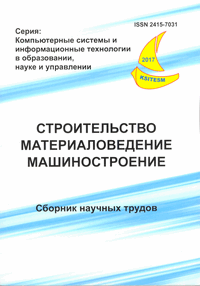Nonlinear dynamic models of constructions, installations and environments in mathematical package Mathcad
Keywords:
structural dynamic, differential equations of motion, time domain, design model, algorithm, MathCADAbstract
The overwhelming majority of the tasks of the dynamics of structures require a nonlinear analysis in the time domain. But modern software based on the finite element method (FEM) can not always solve such complex problems, taking into account all types of nonlinearities. Therefore, there is a need to develop alternative approaches to solving similar problems. In the article discrete mechanical models of environments and constructions whose differential equations of motion are obtained on the basis of general laws of mechanics are considered. Purpose. Formation of systems of differential equations of motion (SDEM) "manually" - a labor-intensive process, associated with a high probability of errors. The purpose of this study is to identify ways of automated obtaining and numerical solution of SDEM dynamic models of structures of the chain structure. Methodology. To describe the motion of models of constructions and environments, differential equations of motion are used in forms known from the courses of theoretical mechanics and structural mechanics. For symbolic and numerical calculations, the MathCAD mathematical package is used. Findings. The results of work on the development of methods for modeling nonlinear dynamics of building objects, environments are presented. The ways of automated acquisition of SDEM for models of the chain structure are shown. On the example of a dynamic beam model in the form of a "straight-line method" and a displacement method, it was found that the equations of motion of such a structure can be obtained both in reverse and in direct way (which essentially extends the possibilities of automation for the acquisition of SDEM of such structures). Practical value. The proposed algorithms can be used in the development of software for modeling the dynamics of buildings and structures.References
Banakh V.A. Statiko-dinamicheskie raschetnye modeli zdaniy i sooruzheniy v slozhnykh inzhenernogeologicheskikh usloviyakh [Static-dynamic research models of buildings and structures in difficult engineering-geological conditions]. Zaporozhye: ZSEA Publ., 2012, 322 p. (in Russian)
Kulyabko V.V. Dinamika konstruktsiy, zdaniy i sooruzheniy. Chast 1. Statiko-dinamicheskiye modeli dlia analiza svobodnykh kolebaniy i vzaimodeystviia sooruzheniy s osnovaniiami i podvizhnymi nagruzkami [Dynamiks of structures, buildings and erections. Part 1. Static-dynamical models for analysis of free vibrations and interaction between erections and foundations and travelling loads]. Zaporozhye: ZSEA Publ., 2005, 232 p. (in Russian)
Kutsenko L. N. and Kolochavin R. M. Opis rukhu n-lankovoho maiatnyka za dopomohoiu operatoriv systemy Maple [Description of movement of a n-link pendulum by means of operators of maple system]. / Applied geometry and engineering graphic, 2012, Issue 90, pp. 166-172. (in Ukrainian)
Panovko Y.G. Vvedenie v teoriiu mekhanicheskikh kolebaniy [Introduction in theory of mechanical oscillations]. Moscow: Nauka, 1980, 272 p. (in Russian)
Sotnikow A.L. Kompiuterno-oriyentirovannyy avtomaticheskiy sintez uravneniy dvizheniia mekhanicheskikh sistem [Computer-oriented automatic synthesis of equations of motion of mechanical systems]. / Automation of production processes in mechanical engineering and instrument making, Donetsk: DNTU, 2008. - Issue 42, pp. 101-122. Available at: http://vlp.com.ua/files/13_59.pdf. (in Russian)
Kulyabko V.,Chaban V., Makarov A. and Yaroshenko D.Taking account of nonlinear properties of subsystems in problems of dynamic interaction of structures with loads, bases and flows / V. Kulyabko, // Nonlinear Dynamics – 2016: Proceedings of the 5th International Conference / National Technical University “ Kharkov Polytechic Institute” at al. – Kharkov, 2016, pp.125-132.
Downloads
Published
Issue
Section
License
Редакція Видання категорично засуджує прояви плагіату в статтях та вживає всіх можливих заходів для його недопущення. Плагіат розглядається як форма порушення авторських прав і наукової етики.
При виявлені у статті більш ніж 25% запозиченого тексту без відповідних посилань та використання лапок, стаття кваліфікується як така, що містить плагіат. У цьому випадку стаття більше не розглядається редакцією, а автор отримує перше попередження.
Автори, в статтях яких повторно виявлено плагіат, не зможуть публікуватися в усіх журналах Видавництва ДВНЗ «Придніпровська державна академія будівництва та архітектури».
Автори, які публікуються у цьому журналі, погоджуються з наступними умовами:
- Автори залишають за собою право на авторство своєї роботи та передають журналу право першої публікації цієї роботи на умовах ліцензії Creative Commons Attribution License, котра дозволяє іншим особам вільно розповсюджувати опубліковану роботу з обов'язковим посиланням на авторів оригінальної роботи та першу публікацію роботи у цьому журналі.
- Автори мають право укладати самостійні додаткові угоди щодо неексклюзивного розповсюдження роботи у тому вигляді, в якому вона була опублікована цим журналом (наприклад, розміщувати роботу в електронному сховищі установи або публікувати у складі монографії), за умови збереження посилання на першу публікацію роботи у цьому журналі.
- Політика журналу дозволяє і заохочує розміщення авторами в мережі Інтернет (наприклад, у сховищах установ або на особистих веб-сайтах) рукопису роботи, як до подання цього рукопису до редакції, так і під час його редакційного опрацювання, оскільки це сприяє виникненню продуктивної наукової дискусії та позитивно позначається на оперативності та динаміці цитування опублікованої роботи (див. The Effect of Open Access).

